
March 2022
The “Green Tide” in Latin
America: A Festival of Class Collaboration
The Struggle for Full Abortion
Rights,
From Latin America to the U.S.
Free Abortion on Demand – For Women’s Liberation Through Socialist Revolution
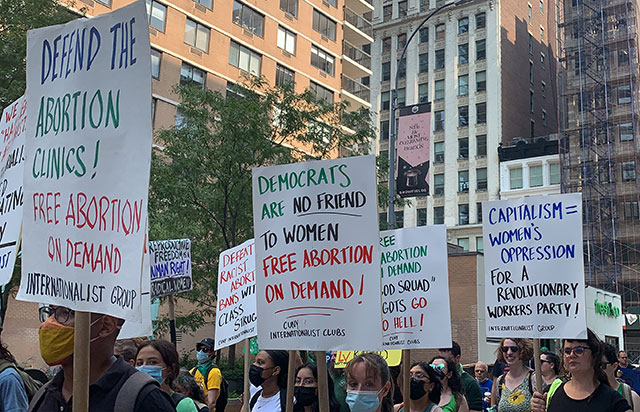
Internationalist contingent at 12 September 2021 NYC protest against Texas anti-abortion law. (Internationalist photo)
MARCH 8 – On this International Women’s Day, the battle over abortion is at a critical point throughout the Americas. As reactionary forces in the United States wave the banner of the “right to life” and “the family” to eliminate rights won in the past, elsewhere in the hemisphere there has been an upsurge in actions to eliminate laws that have sent thousands of women to jail for the “crime” of ending an unwanted pregnancy – or even for having a miscarriage. Everywhere, the issue of control of women’s bodies by the state is poised point-blank, as decaying capitalism endangers the rights of all the oppressed. The pending calamity in the U.S., where the constitutional right to an abortion is on the verge of being eliminated after being in force for a half-century, underlines the need for a revolutionary class struggle for the liberation of women.
In Latin America much has been made of an advancing Marea Verde or “Green Tide,” as feminist groups have labeled the mass mobilizations in Argentina that won a partial legalization of abortion. The National Campaign for the Right to Legal, Safe and Free Abortion in Argentina goes back to 2003, growing out of the 18th Encuentro Nacional de Mujeres (National Meeting of Women).1 At that conference, it was decided to adopt as symbol of the abortion rights campaign the bandanna associated with the Grandmothers and Mothers of the Plaza de Mayo,2 but dying it green to signify life. In early 2018, it was announced that a legislative debate and vote on legalizing abortion would be held. In response, a pañuelazo (bandanna action) was held outside the Argentine Congress that drew thousands of young women in particular, all sporting green bandannas. This gave rise to the “Green Tide” of mass mobilizations lasting until Congress finally approved the Law for Voluntary Interruption of Pregnancy (IVE) in the last days of 2020.
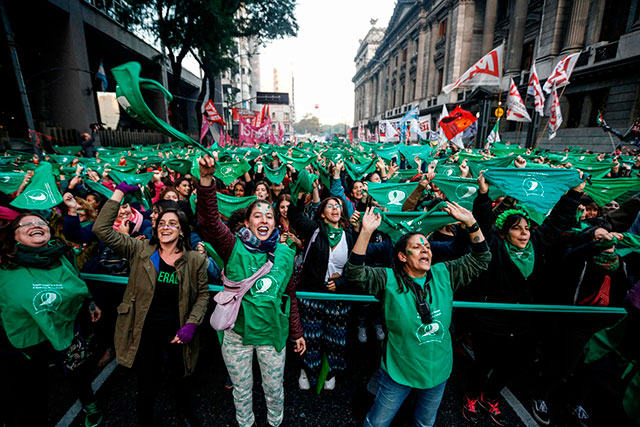
Feminist activists sporting green bandanas march through Buenos Aires, Argentina, 28 May 2019, demonstrating in support of a bill to legalize abortion. (Photo: Emiliano Lasalvia)
Elsewhere in the continent, the Marea Verde/Green Tide has been presented as a “feminist revolution.” Yet the Argentine National Campaign for Abortion Rights was begun by mainstream professional women (doctors, lawyers and academics), and selection of the symbol of the green bandanna was made in an accord with the organization Catholic Women for the Right to Decide. The prior feminist movement, Ni Una Menos (Not One Less), protesting murders of women, was built in collaboration with capitalist politicians and the Catholic church.3 Unlike in many countries where bourgeois politics is marked by a counterposition of social and economic conservative forces on one side and social/economic liberals on the other, in Argentina defenders of abortion rights are found both among supporters of right-wing president Mauricio Macri (2015 to 2019), and of the populist Frente de Todos (Everyone Front) now in office.
The Frente de Todos is the current political expression of Peronism,4 which specializes in coopting protest movements and integrating them into its clientelist patronage networks. The IVE bill was debated (and defeated in the Senate) when it was filed for the seventh time in 2018 under President Macri. But finally, on 30 December 2020, under the Peronist government Law 27,610 was passed legalizing abortion in the first 14 weeks of gestation. This was a notable advance for women's rights in Argentina and in much of Latin America, where abortion has been treated as a serious felony. Yet despite the praise from the left, the Green Tide that mobilized for this law was hardly radical. Rather, it is a festival of class collaboration led by bourgeois political currents – bringing with it obstacles and limitations to winning crucial rights, let alone the actual liberation of women.
A central figure in this is Cristina Fernández – wife of the late president Néstor Kirchner, herself former president (from 2007 to 2015), and current vice president – who is the standard-bearer of the Kirchnerist current of Peronism. Under her presidency she was explicitly anti-abortion, but after her chosen successor was defeated in the 2015 elections – and after the size of protests showed electoral winds blowing in a new direction – she came out in favor of abortion rights in 2018. In the 2019 election campaign, current president Alberto Fernández (no relation) likewise endorsed the decriminalization of abortion. In the #AbortoLegal2020 campaign, mass vigils and sit-ins in front of Congress served as a sounding board for Frente de Todos legislators. These bourgeois politicians replaced the feminists’ bill with their own version that was approved with a predominantly Peronist majority, but also with support from members of the Unión Cívica Radical (UCR) and other traditional conservatives, as well as from the Frente de Izquierda y de los Trabajadores – Unidad (FIT-U, United Left and Workers Front) electoral coalition.

Hard-line abortion opponent Juan Manzur and Cristina Fernández. (Photo: Punto a Punto)
Approval of the IVE law in Argentina had a great impact throughout the continent. But after initial celebrations died down, since the very first days of 2021 attempts to sabotage it have multiplied: legal appeals to declare the law unconstitutional, injunctions in several states to suspend its application, and above all refusal to perform abortions by doctors under the “conscience clause” contained in the law. Then, after the Frente de Todos suffered a defeat in the November 2021 midterm parliamentary elections, Alberto Fernández appointed as head of his cabinet (at the suggestion of vice president Cristina Fernández) an infamous abortion-rights opponent, Juan Manzur, who as governor of Tucumán required that an eleven-year-old girl, Lucía, give birth even though she had requested an abortion because she had been raped.
In the November elections, the Partido de los Trabajadores Socialistas (PTS), part of the Trotskyist Fraction (FT) international current and a leading component of the FIT-U, criticized the appointment of Manzur and accused “the Frente de Todos and its feminist, union, political, student and related social movements” of “demobilizing the women's movement.” Yet at the same time, representatives of Pan y Rosas (Bread and Roses), a feminist tendency linked to the PTS, were engaging in sisterly outreach to Ofelia Fernández, a young Buenos Aires legislator and rising star of the Kirchnerist Frente Patria Grande (Broad Fatherland Front), only gently criticizing the “lukewarmness” of her concept of “popular feminism.”
The PTS-affiliated “socialist feminists” say they are for “the organization of a women’s movement independent of the state, which has no commitments to the governments of the day.”5 Yet with its effusive praise of the Green Tide and enthusiastic and almost entirely uncritical support for the #AbortoLegal2020 campaign, the pseudo-Trotskyist PTS was in fact part of a popular-front feminist movement of support for the Peronist “government of the day.”
Peronism is and has been a pillar of capitalist politics in Argentina since the times of General Perón in the mid-20th century. This populist current plays a key role in subjecting labor unions and popular movements to the tutelage of a sector of the bourgeois ruling class, almost always with opportunist “socialists” as the caboose of the populist train. Its role in the struggle for the right to abortion is a repeat of this pattern. Authentic Trotskyists would have voted critically in favor of even the very partial legalization of abortion that was put to a vote in 2020, while insisting at all times on the unconditional right to abortion at any time during pregnancy, and calling for a political break with the Frente de Todos and all bourgeois politicians, parties and coalitions. But it will take a socialist revolution to win the right to free abortion on demand.
Abortion Rights Under Frontal Assault in the U.S.
Winning a limited legalization of abortion by legislation in Argentina, and now through court decisions in Mexico, sent a wave of excitement and hope throughout Latin America (see “Mexican Trotskyists Call for Free Abortion on Demand,” The Internationalist No. 65, October-December 2022). However, north of the border in the United States, there is a wave of fear of an imminent overturn of the individual right to abortion that was established in the 1973 Roe v. Wade Supreme Court decision. Almost simultaneous with the Mexican Supreme Court’s ruling declaring outright bans on abortion unconstitutional, an extreme anti-abortion law in Texas – SB8 – took effect. This would outlaw abortion after the first six weeks into pregnancy with no consideration for rape victims. Even more immediate is the threat of a Mississippi law, now before the U.S. Supreme Court, which could be the occasion for the right-wing anti-abortion supermajority on the Court to overturn Roe v. Wade altogether. Similar “heartbeat” laws, supposedly based on detection of cardiac activity in an embryo, have since been passed in other states with Republican-dominated legislatures, including Kentucky, Georgia and Ohio.
The issue is sharply posed of how to fight against the broadscale assault on women’s rights, abortion rights, gay and transgender rights. Some mainstream bourgeois feminists have declared the court battle lost: “Roe Is as Good as Gone. It’s Time for a New Strategy,” headlined the New York Times (1 November 2021). So what is this “new strategy”? It is protests, boycotts and above all seeking “political power, and that means getting active in electoral politics” – in other words, vote for the Democratic Party. But that has been the dead-end “strategy” of the bourgeois feminist movement since whenever. What they foresee, given that the anti-abortion movement is based on asserting “states’ rights” to ban abortion, is a fundamental social divide between “red” (Republican) states, where abortion is banned, gay and trans rights are denied and demonized, etc., and “blue” (Democratic) states, where abortion (with limits) is legal and those rights are affirmed, at least formally, plus some “purple” states where the battle hangs in the balance.

Pseudo-socialists call for a “mass movement” together with bourgeois feminists. Like who? Take Gloria Steinem, for example, who keynoted the Democrats’ January 2017 Women’s March in Washington D.C. From the late 1950s to the early 1970s, Steinem was a CIA “asset” working with the imperialist spy agency in the anti-Soviet Cold War fingering leftists while infiltrating women’s organizations in the U.S. (John Minchillo / AP)
Among petty-bourgeois feminists, the new-old strategy is to build a “mass movement” to engage in pressure politics in the streets. The online media outlet Left Voice embodies this political line, declaring that the struggle for abortion rights will be won “as a result of a mass heterogenous movement” modeled after the Marea Verde (Green Wave) in Argentina. LV, which is part of a “network” of digital publications affiliated with the Trotskyist Fraction, wrote that in Argentina “while the capitalist parties of all stripes had members [who] refused to support the right to an abortion, the mass movement resulted in a victory” (“We Need a Mass Movement to Defend Abortion Rights and We Need it Now,” 4 September 2021). What they are calling for is basically a “militant” brand of lobbying. And what does a “mass heterogeneous movement” mean? They are talking of a movement embracing bourgeois feminist politicians, as in Argentina. This is the politics of class collaboration, and anywhere and always the bourgeois components – in Argentina, the Peronists, in the U.S., Democrats – set the real agenda.
In building “heterogeneous” mass movements involving different and counterposed class forces, according to the logic of the lowest common denominator, it is the more “moderate” elements that will prevail. In Argentina, Peronist Cristina Fernández declared in 2005 that she was opposed to abortion. In the U.S., Democrat Hillary Clinton declared in 2007 during her first presidential run that abortion should be “safe, legal and rare, and by rare, I mean rare.”6 If pressure from mass movements could move them, it was only to a degree. The partial legalization of abortion in Argentina is a significant gain in a country dominated by the Catholic Church, but the limitations of the law are real: not only the “conscience clause” allowing doctors to refuse to perform the procedure, but also the restriction to the first 14 weeks of pregnancy. In the United States, the Mississippi law rolling back abortion rights would ban abortion after 15 weeks. Yet the PTS’ deputies in the Argentine legislature, at least according to posts on the FT’s Izquierda Diario website, had only the barest criticism of the conscience clause (a couple of interventions in support of a “partial dissent” in committee) and evidently no attempt to amend, in a deluge of daily articles for the law.
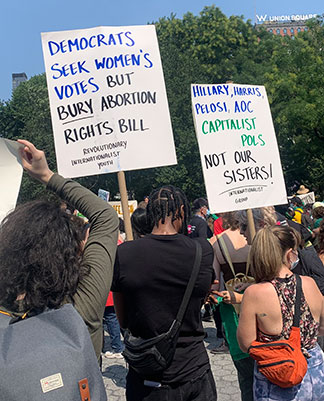
Internationalists at 12 September 2021 NYC abortion rights rally denounce the Democratic Party, which campaigns for women’s votes but blocks struggle for full abortion rights.
(Internationalist photo)
Another article on the FT’s U.S. website declared that in a 2 October 2021 nationwide “Women’s March,” LV would “march for the right to free, safe, legal abortion on demand and without apology.” But while the article said that “we can’t trust the courts or the Democrats,” those “mass heterogeneous” marches were in fact rallies to build support for the Democrats in the midterm November elections. The Internationalist Group participated in a September 12 NYC abortion rights rally called by LV and other assorted leftists. Our signs called to “Defend the Abortion Clinics,” for “Free Abortion on Demand” and “Labor: Defend Trans, Gay and Lesbian Rights!” We also warned, “Democrats: No Friends of Women,” “Democrats Seek Women’s Votes But Bury Abortion Rights Bill,” and “Hillary [Clinton], [Kamala] Harris, [Nancy] Pelosi, AOC [Alexandria Ocasio-Cortez], Capitalist Pols – Not Our Sisters!” But the IG did not join in the October 2 get-out-the-vote-for-Biden-and-the-Democrats marches that Left Voice helped build.
The LV article for the October 2 rally headlined: “Free, Safe, Legal Abortions Will be Won in the Streets” (Left Voice, 2 October 2021). But although it is a simple democratic demand, the right to free abortion on demand will not be won simply by marching in the streets. In the U.S., under the standard set in Roe v. Wade and the accompanying Doe v. Bolton ruling, abortion may be performed even in late-term or third-trimester (after 24 weeks) pregnancy if needed for “preservation of the … health of the mother.” “Health,” according to examples cited in Roe, could include the “stigma of unwed motherhood,” the burdens of childcare and “the distress, for all concerned with the unwanted child.” But aside from abortion not being free (the 1976 Hyde Amendment, passed under the Democratic administration of Jimmy Carter, prohibits federal funds to pay for abortions), this is still qualitatively different from abortion on demand. Whether under “welfare-state” capitalism in Scandinavia or in the U.S. “free-market” variety, the right to abortion is not available at the sole decision of the pregnant person.
The Family: Building Block of Capitalist Society, and of Women’s Oppression
Why is this simple medical procedure everywhere regulated by the state, and denied to millions of women, causing tens of thousands of maternal deaths every year? There is, of course, the opposition of Catholic, Evangelical, Muslim and Jewish religious fundamentalists who claim that a fetus in the womb is an “unborn person,” or who oppose women’s right to control their bodies altogether. But beyond the “god squad” bigots who besiege abortion clinics – and even murder abortion providers in the name of a hypocritical “right to life” – the fact is that almost no bourgeois politician backs full rights to abortion because they all support the family, the building block of capitalist society. A woman’s right to choose to bear children or not could lead to a decline in births and undermine a social order built on the subjugation of women. That is also a reason why gay and transgender rights are deemed subversive. And it is key to the core of anti-abortion hysteria: for the racists, not enough white babies are being born.7 Black, Latino and immigrant women, in contrast, are often subject to involuntary abortions and forced sterilization.

Revolutionary Marxists have always been in the forefront of the struggle against women’s oppression and for equality. In his fundamental work, The Origin of the Family, Private Property and the State (1884), Friedrich Engels writes (Chapter 2): “The first class opposition that appears in history coincides with the development of the antagonism between man and woman in monogamous marriage, and the first class oppression coincides with that of the female sex by the male.” In the monogamous marriage, he goes on, “the supremacy of the husband over the wife in the modern family, the necessity of creating real social equality between them, and the way to do it, will only be seen in the clear light of day when both possess legally complete equality of rights. Then it will be plain that the first condition for the liberation of the wife is to bring the whole female sex back into public industry, and that this in turn demands the abolition of the monogamous family as the economic unit of society.”
In the Communist Manifesto (1848), Marx and Engels famously called for the “Abolition of the family!” adding, “Even the most radical flare up at this outrageous proposal of the communists.” This is as true today as it was then, and even many Stalinist and social-democratic reformists join in seeking to bury this revolutionary call. Maoists of all stripes declare the family to be a “fighting unit of socialism.”8 But what does that mean, “abolition of the family”? In the Internationalist Group pamphlet edition of the Manifesto we included an explanatory footnote:
“Here and throughout the Manifesto when speaking of ‘abolition,’ the original German is Aufhebung, which also denotes overcoming, superseding. In Hegel’s dialectic, the Aufhebung represented the resolution of a contradiction. Thus the meaning of Marx and Engels’ phrase included the concept of the superseding of the family by higher, collective social institutions.”
Engels spelled this out in The Origin of the Family…:
“With the transfer of the means of production into common ownership, the single family ceases to be the economic unit of society. Private housekeeping is transformed into a social industry. The care and education of the children becomes a public affair; society looks after all children alike, whether they are legitimate or not.”
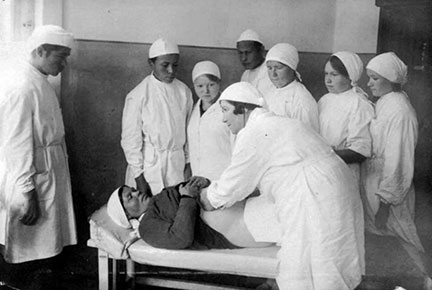 An abortion clinic in the
early Soviet Union. In 1920, under Lenin and Trotsky, Soviet
Russia became the first country in the world to permit
abortion, free and on request, at all stages of pregnancy.
Later, Stalin rolled back many of the gains of women.
An abortion clinic in the
early Soviet Union. In 1920, under Lenin and Trotsky, Soviet
Russia became the first country in the world to permit
abortion, free and on request, at all stages of pregnancy.
Later, Stalin rolled back many of the gains of women. (Photo: russianphoto.ru)
We fight for demands such as free 24-hour childcare which point to such institutions of a socialist society, along with democratic demands like free abortion on demand which will not be fully realized without a revolution as they affect vital institutions of capitalist society. In the early years of the Bolshevik Revolution under Lenin and Trotsky not only was equality of men and women before the law established, along with freedom of divorce and abolition of laws against homosexuality and sodomy, but in 1920 Soviet Russia became the first country in the world to permit abortion, free and on request, at all stages of pregnancy. At the same time, a start was made in establishing daycare centers, low-cost restaurants and laundries. But the material conditions of an economically backward country besieged by imperialism imposed limitations, and with the bureaucratic political counterrevolution under Stalin after 1924, these gains were rolled back, to the point that in 1935 abortion was made illegal. The family was rehabilitated at the expense of women’s rights.9
Yet a collectivized planned economy can lay the basis for the liberation of women. In fact, in places such as the German Democratic Republic (DDR) – the East German bureaucratically deformed workers state – low-cost restaurants, laundries, daycare centers and other socialized means of overcoming domestic slavery of women became possible, as women were “brought back into public industry,” with 95% employed outside the home. This also made possible a largely unrestricted right to abortion. But as a result of capitalist counterrevolution, the right to abortion was almost entirely eliminated in places like Poland, leading to recent struggles, and in reunified imperialist Germany abortion is still illegal (though not prosecuted in the first trimester).
Bottom line: overcoming the oppression of women is impossible under capitalism. The League for the Fourth International fights for women’s liberation through socialist revolution.
Feminists Accept the Framework of Capitalism
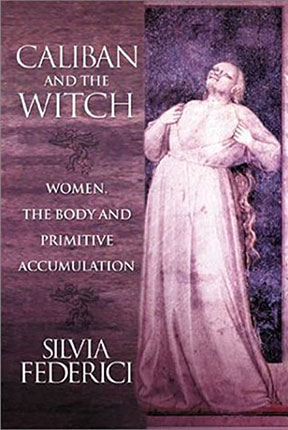
Ruling-class feminists are not the only ones who refuse to call for abolition and replacement of the family by socialized institutions to overcome household drudgery. This is also the case of many petty-bourgeois leftist feminists. An example is Silvia Federici, the Italian American “autonomist” feminist who is often cited by “radicals” in Mexico and elsewhere. Known since the 1970s for her participation in the “wages for housework” movement along with Selma James10 and Mariarosa Dalla Costa, Federici has become something of a guru to feminists close to Zapatismo and even in circles claiming to be Marxist. The Trotskyist Fraction has flirted with Federici, writing that her “contributions are important” and complaining that “different currents use Silvia Federici to make criticisms of Marxism.”11 Even with her recent sharp denunciations of Marxism, the FT makes only the most lukewarm, implicit criticism of this icon of “radical” feminism. In fact, Federici’s feminism has always been deeply anti-Marxist. Her first major work, Caliban and the Witch (2004), upholds the absurd thesis that women in Europe supposedly enjoyed far greater freedom in the feudal Middle Ages but were then enslaved by capitalism.
Using supposedly Marxist language, Federici’s recent collection of essays titled Patriarchy of the Wage: Notes on Marx, Gender and Feminism (2018) is in fact an extended jeremiad against Marxism. (The Spanish edition makes this explicit, with the second part of the title reading: “Feminist Critiques of Marxism.”) She argues that “Marx’s lack of interest in domestic labor” was because it seemed “an archaic form that would soon be superseded by the progress of industrialization.” This leads her to say that “we have been forced to reconsider one of the main dogmas of Marx’s theory of revolution,” namely that “capitalism and modern industry are prior conditions to free humanity from exploitation.” Instead, this could supposedly be accomplished by dispersed communities (“commons”) based on “cooperative association.”
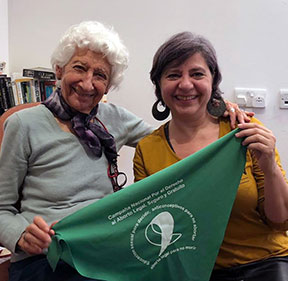 Selma James (left) with
the Trotskyist Fraction’s Andrea D’Atri and the green
bandana. (Photo: Izquierda
Diario)
Selma James (left) with
the Trotskyist Fraction’s Andrea D’Atri and the green
bandana. (Photo: Izquierda
Diario)In one of the essays, Federici declares that male workers who “called for the exclusion of women from the factories and other workplaces, arguing that their place was in the home,” supposedly showed that “the interests of the proletarian man and the capitalist coincided in this aspect.” Her grotesque claim that this classic example of bourgeois false consciousness somehow represented the interests of the male workers is nothing but a “theoretical” aid to the capitalists, an attack on women workers and sabotage of the Marxist struggle to unite men and women workers against male chauvinism, discrimination and oppression of women in the workplace. In a similar vein, Selma James argued that women who go to work the workplace are scabs.12
In arguing for Zapatista-style “commons” instead of communism, Federici basically accepts the capitalist framework, and denies that liberation of women must be based on developing the productive forces in a socialized economy. In a pamphlet praised by anarcho-syndicalists she claimed that socialization of housework amounts to “state” control. She instead calls for “wages for housework.” Women must embrace the role of housewife, she holds, to “realize that they are housewives too” and denial of this amounts to “a weakness which is maintained and perpetuated through the lack of self-identification.” Federici continues,
“We want and have to say that we are all housewives, we are all prostitutes and we are all gay, because until we recognize our slavery we cannot recognize our struggle against it, because as long as we think we are something better, something different than a housewife, we accept the logic of the master, which is a logic of division, and for us the logic of slavery.”
–Silvia Federici, Wages Against Housework (1974)
Federici argues that recognition of all women as housewives, and of housework and “reproductive labor” as social labor, grants women recognition as workers, collective bargaining and strike action rights, and negates the existing “social contract” of unpaid housewife duties that women across the planet have supposedly accepted. As she puts it, “From now on we want money for each moment of it, so that we can refuse some of it and eventually all of it.” Not only does this view wholeheartedly accept the family, it makes a virtue of women’s oppressive separation from social labor – implying that women doubly exploit themselves if they take on “second jobs”! This accepts the man as “boss,” and thus lets the bourgeoisie off the hook for its brutal exploitation of working-class men and women.
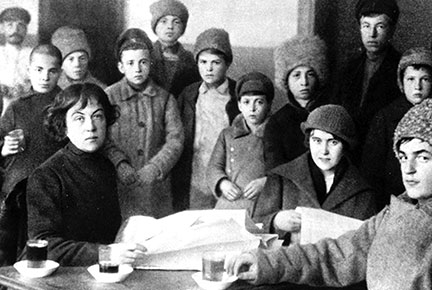 Alexandra Kollontai with
children oprhaned in the Civil War against Soviet Russia by
counterrevolutionary forces allied with imperialism.
Kollontai was co-founder of the Zhenotdel, the Communist
Party's women's department, responsible for the first-ever
legalization of abortion, and a trenchant critic of
feminism.
Alexandra Kollontai with
children oprhaned in the Civil War against Soviet Russia by
counterrevolutionary forces allied with imperialism.
Kollontai was co-founder of the Zhenotdel, the Communist
Party's women's department, responsible for the first-ever
legalization of abortion, and a trenchant critic of
feminism. More than that, it reeks of petty-bourgeois privilege, for if the goal is to “refuse” all domestic tasks, rather than to socialize them, and if the answer is pay for them, why then a woman can simply hire another woman – her “sister” – to sell her labor power and perform those tasks for a measly slave wage. This, moreover, is exactly what happens today under capitalism, as bourgeois and petty-bourgeois women hire other women – many of them undocumented black and Latina immigrants – to clean the house, care for children and keep the household functioning. This underscores the argument of Bolshevik women’s leader Alexandra Kollontai that the feminists are only seeking privileges for themselves:
“For the majority of women of the proletariat, equal rights with men would mean only an equal share in inequality, but for the ‘chosen few,’ for the bourgeois women, it would indeed open doors to new and unprecedented rights and privileges that until now have been enjoyed by men of the bourgeois class alone. But each new concession won by the bourgeois woman would give her yet another weapon for the exploitation of her younger sister and would go on increasing the division between the women of the two opposite social camps. Their interests would be more sharply in conflict, their aspirations more obviously in contradiction.”
–Kollontai, “The Social Basis of the Woman Question” (1909), reprinted in the Internationalist pamphlet, Bolsheviks and the Liberation of Women.
What a “Heterogeneous” Women’s Movement Leads To
In its article for the 2 October 2021 Democratic Party “women’s march” headlining that abortion rights “will be won in the streets,” LV presents a skewed picture of how Roe v. Wade came about, referring to tens of thousands in the streets to bend the Supreme Court to the will of the masses. It also cites the “context” of antiwar marches, the civil rights movement, the New Left, etc. Certainly, the conservative justices in their black robes didn’t decide on the basis of arcane legal reasoning that abortion was constitutionally protected due to a woman’s right to privacy. But what led the bourgeoisie to take this step went far beyond street protests. U.S. society was blowing up, with ghetto upheavals across the country, cities under martial law enforced by the army and National Guard, workers occupying auto plants, while a losing war was waged in Indochina, where U.S. soldiers refused orders and even “fragged” officers using fragmentation grenades. In these conditions, the right to abortion was conceded, a moratorium was declared on the racist death penalty, and laws were passed limiting government secrecy and presidential war powers.
 Anti-Communist CIA asset
Gloria Steinem conferring with red-baiter Lucy Komisar at
the First National Women’s Conference, 1977. Call for a
“heterogeneous” multi-class “mass movement” with bourgeois
feminists and this is what you get.
Anti-Communist CIA asset
Gloria Steinem conferring with red-baiter Lucy Komisar at
the First National Women’s Conference, 1977. Call for a
“heterogeneous” multi-class “mass movement” with bourgeois
feminists and this is what you get. (Photo: Diana Mara Henry)
The bourgeois feminist organizations LV cites were built in good part to head off the rising New Left and radical feminist movements. An object lesson of what building a “heterogeneous” multi-class – i.e., class-collaborationist – “mass movement” for women’s rights leads to was provided by the Socialist Workers Party (SWP) foray into the National Organization for Women (N.O.W.), the premier bourgeois feminist organization in the U.S. The SWP’s vehicle was the Women’s National Abortion Action Coalition (WONAAC), a reformist outfit run by these long-since ex-Trotskyists. Naturally, the SWP sought to win people to its politics. But typically for reformists, it mainly sought organizational control rather than waging a political battle against the liberal Democrats, which it would only lose. But at a September 1971 N.O.W. national conference, the SWP went head-to-head with the N.O.W. leadership leading to an explosion of the most vicious redbaiting.
The dispute arose over a proposal to endorse WONAAC efforts to coordinate a national campaign to repeal all anti-abortion laws, leading up to the 20 November 1971 demonstrations in Washington, D.C. and San Francisco that LV hails. But underlying this was the unvarnished anti-communism of forces in the N.O.W. leadership that wanted to turn away from mass demonstrations to working within the Democratic Party. At the September 1971 N.O.W. convention, a resolution condemning the SWP for “dividing and exploiting” the women’s movement for its “own goals and purposes” was authored by one Lucy Komisar. While that motion was voted down, another was passed to condemn in general any organization that “divides and exploits” the women’s movement. But that was not the end of it. A few months later, Komisar turned in a “Confidential Report to the NOW Governing Board on the Activities of the Socialist Workers Party and the Young Socialist Alliance” that called for the organization “not to have any dealings with SWP/YSA members and groups.”
 The
ex-Trotskyist Socialist Workers Party sought in vain to win
bourgeois feminists to support November 1971 WONAAC abortion
rights demo. N.O.W. responded with anti-communist witch
hunt.
The
ex-Trotskyist Socialist Workers Party sought in vain to win
bourgeois feminists to support November 1971 WONAAC abortion
rights demo. N.O.W. responded with anti-communist witch
hunt.Komisar was working with the Women’s Political Caucus, which likewise called to work within and support the capitalist Democratic Party. But rather than combatting this bourgeois political program directly, a convention of the SWP passed a resolution declaring: “No matter what orientation women’s groups have toward lobbying and toward elections, we should all be able to unite to show our strength behind an issue like the repeal of all abortion laws.” The resolution continued: “The truth is that women are at the same time both united by sexist oppression and divided by class society. There is an objective basis for a unified struggle of women of different nationalities and classes because all women are oppressed as women by capitalism” (“NOW, Women’s Political Caucus, & Nov. 20,” The Militant, 19 November 1971). In fact, the class contradictions are fundamental. The liberal Democratic women doctors, lawyers, professors and businesswomen of N.O.W. were adamant in calling to reform anti-abortion laws, not abolish them, and in kicking out any “reds” (or even pale pink social democrats like the SWP) who might get in the way.
So much for a “heterogenous mass movement” for abortion rights: it was tried then and the bourgeois ladies called the shots. Try again and the result will be the same. Racial, gender and economic equality was not in the bourgeois feminists’ program: they were and are, as Kollontai explained, concerned to gain privileges for themselves. The logic of feminism, of every variety is to call for the unity of all women. Against what or whom? Men? Or “the Patriarchy?” That may sound radical, but it in fact it preserves the bourgeois family as the basic unit of society. The struggle against women’s oppression is not at bottom a gender struggle, or simply a struggle for democratic rights (as many liberals and reformists hold), or an “intersectional” struggle of multiple oppressed sectors (with often conflicting interests) as the “left” purveyors of identity politics pretend. It must be a class struggle of all the oppressed against the capitalist system that exploits and oppresses us all, leading to the revolutionary overthrow of that system.
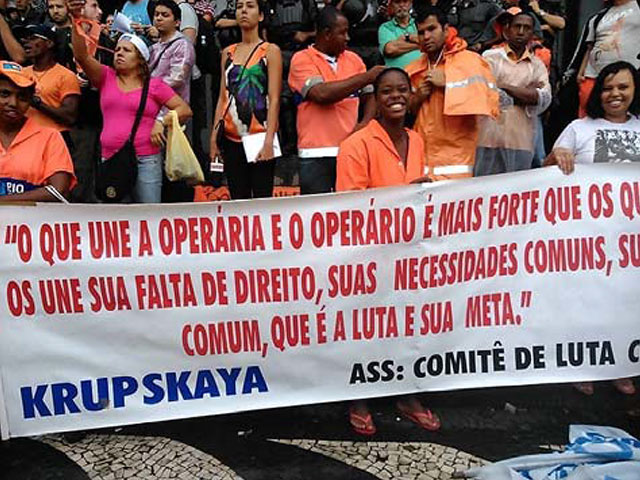
Our comrades of the Class Struggle Committee and Liga Quarta-Internacionalista do Brasil in 2014 International Women's Day march with striking sanitation workers in Rio de Janeiro. Quote from Bolshevik leader Nadezhda Krupskaya reads: “What unites men and women workers is stronger than what divides them. They are united by their lack of rights, their common needs and their common situation, which is the struggle for their goal.” (Photo: CLC)
The real struggle has to be a common struggle of both proletarian women and men against all forms of oppression, not sectoralism and class collaboration. This basic issue has bedeviled the feminist movement going back to the post-Civil War 15th Amendment (1870) prohibiting limiting or denying the right to vote “on account of race, color, or previous condition of servitude.” Because that meant granting black men the right to vote while it was still denied to women, many feminists opposed it, allying with notorious pro-lynch-law bourgeois politicians after breaking with the Equal Rights Association.13 But this is not just a “women’s issue.” The fight for abortion rights and the liberation of all the oppressed is crucial to the class struggle. That’s why the transitional organizations fraternally allied with the League for the Fourth International (Class Struggle Education Workers, Class Struggle Workers – Portland, Trabajadores Internacionales Clasistas, Comité de Luta Classista n Brazil) all call in their founding statements for free abortion on demand, as well as for full citizenship for all immigrants.
Any “strategy” purporting to win fundamental gains through a class-collaborationist, “heterogeneous mass movement” is doomed to failure. For women to be truly free, to win full rights to abortion and for those rights be available to all pregnant people regardless of their economic, racial and legal status, it is necessary, precisely as Friedrich Engels and the Communist Manifesto stated, to abolish the family as the basic unit of society and to replace domestic slavery with socialized institutions, which require a socialist revolution to be achieved. ■
Democrats Uphold the Hyde Amendment
Race, Class and
the Right to Abortion
 Democrats Jimmy Carter
and Joe Biden supported the Hyde Amendment. (Photo: Barry Thumma / AP)
Democrats Jimmy Carter
and Joe Biden supported the Hyde Amendment. (Photo: Barry Thumma / AP)Women’s right to abortion is also a race and class issue. Across the country, at least 59% of women who obtained legal abortions in 2019 were black and Latina, according to the Kaiser Family Foundation. Moreover, “75% of women who obtain abortions are low-income, with nearly half living below the federal poverty level” (MarketWatch, 4 October 2019). Today, with the passage and implementation of severe anti-abortion laws, these women are particularly at risk. In Texas, where the new law bans abortion after the first six weeks, 27% of those receiving abortions reported in 2018 were black women and 39% were Latina women (“Texas abortion law will hurt people of color, those with low incomes and other marginalized groups, advocates say,” MarketWatch, 4 September 2021). And in Mississippi, where Roe v. Wade is immediately threatened, 74% of reported legal abortion patients were black women in 2019 (“Distribution of legal abortions in Mississippi in 2019, by ethnicity,” Statista, 2 December 2021).
What these statistics show is that the drive to ban abortion is deeply racist (see “Defeat Racist Abortion Bans With Class-Struggle Action,” The Internationalist No. 56, May-June 2019). This is underlined by the Texas law, SB 8, under which it is not the state that enforces the law, but rather private citizens have effectively been deputized to carry it out, by giving anyone legal standing to sue those who perform or aid abortions, including taxi drivers who taken women to an abortion clinic! The purpose of this subterfuge is to make it difficult to challenge in court, as it is not the state or a state agency enforcing the law but individuals bringing the claim. And individuals are given an incentive to sue in the form of a $10,000 award per case won, in addition to covering all legal costs. This empowerment of “bounty hunters” is reminiscent of the 1850 Fugitive Slave Act, which also doled out hefty monetary rewards for the capture and return of escaped slaves. This abomination was only ended by the Civil War, which abolished slavery by force of arms, later codifying this through Constitutional Amendments.
After the 1973 Roe v. Wade Supreme Court decision established the right for women to have an abortion, in the years that followed Medicaid paid for about 250,000 to 300,000 abortion procedures per year for low-income women. But there was an immediate backlash, ultimately resulting in the 1976 Hyde Amendment, to prevent federal funds from paying for abortion, except in to save the life of the women (later expanded to include victims of rape and incest). Both Democratic Party president Jimmy Carter, who signed the bill including the amendment, and Democratic then-senator Joe Biden supported Hyde, and Biden continued to vote for it year after year as it is a rider to the federal budget bill that must be repeatedly renewed. Only in 2016 did the Democratic Party finally call to repeal the Hyde Amendment, and only in 2020 (after coming under fire in the presidential race) did Biden pledge to overturn it if elected.
In 2019, Democrats Alexandria Ocasio-Cortez and Ayanna Pressley introduced an amendment to repeal Hyde, but it was never voted on in the House of Representatives, as Democratic Speaker Nancy Pelosi said she “didn’t see an opportunity to get rid of [Hyde]” under Trump. In 2021, Biden introduced a Hyde-free budget, but that has gone nowhere and the ban on federal funds for abortions for poor women is still law, thanks to Republicans and Democrats. ■
“No Cis Dudes”:
Feminist Sectoralism Ad Absurdum
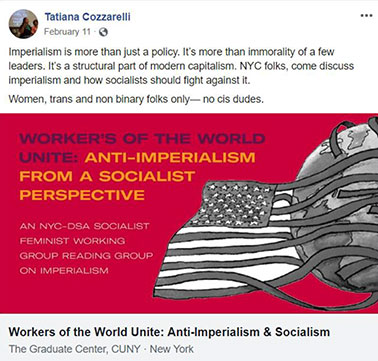
In Argentina the pseudo-Trotskyist milieu is large enough to boast of its presence in congress, while internationally the “Trotskyist Fraction” (FT, from its initials in Spanish) has brought its Argentine section’s feminist Pan y Rosas (Bread and Roses) franchise to Mexico, Bolivia and elsewhere. In the United States, the FT’s Left Voice Internet media outlet is bereft of a “mass” milieu to tail after and offer helpful advice to. As hot air from Vermont senator and former Democratic presidential candidate Bernie Sanders was ballooning the Democratic Socialists of America (DSA), LV tried its hand at a kind of entrism ... into this pressure group in and on U.S. imperialism’s Democratic Party.
There, finding a niche in the NYC DSA Socialist Feminist Working Group, LV’s pandering led to lengths that less unrestrained opportunists might have found embarrassing. This included putting on a DSA reading group on “Anti-Imperialism from a Socialist Perspective” in April 2020 whose advertisement specified that “no cis dudes” could attend. That the author of Imperialism: The Highest Stage of Capitalism would presumably have been banned (not to mention many of the world’s most renowned anti-imperialist fighters, from Vietnam to Angola to Cuba) apparently did not trouble LV, any more than the absurdity of tacking the slogan “Workers of the World Unite” onto a male-exclusionary event. At the same time, seeking to market its brand of “Marxism”-lite as innocuously hip and inoffensive to its social-democratic siblings, LV says “Lenin Would Be a Beast on Twitter”, posts “socialist” musings on Valentine’s Day, etc. This is pop-pseudo-Marxism ad absurdum … and ad nauseam. In fact, the cutesy gimmicks serve a political purpose: signaling to all and sundry (and ultimately the ruling class) that this is not a serious group fighting for power.
With its tailist outlook and political appetites, it is logical that LV’s portrayal of the abortion rights movement of the early 1970s echoes the politics that the reformist, ex-Trotskyist U.S. Socialist Workers Party was peddling at the time, to the disgust of tens of thousands of radical leftists. Left Voice sees it as a model because it wants to play a similar role, and not just on the woman question. LV articles have repeatedly praised the SWP of that period, including its role as brokers for the “antiwar” fronts of that time, whose basis was explicit class collaboration, putting Democratic imperialist politicians on the platforms of “peace” marches. (This was also when the SWP served as international publicists for the FT’s forebears in Argentina, the ultra-reformist Partido Socialista de los Trabajadores of Nahuel Moreno.)
This tradition that LV and the FT are latching onto is that of the popular front, not of revolutionary Trotskyism. It is clearly counterposed to that of the Revolutionary Tendency, formed by the founders of the SWP’s youth organization, which in the early 1960s fought to uphold the program of Lenin and Trotsky and was expelled by the SWP as that formerly Trotskyist party moved from a period of centrist degeneration to the embrace of open class collaboration. While the SWP tailored its “Bring Our Boys Home” social-patriotism to its bourgeois allies in the “antiwar movement,” genuine Trotskyists stood for victory to the Vietnamese revolution, raising the calls for “Labor Strikes Against the War” and “All Indochina Must Go Communist” together with the fight for free abortion on demand and women’s liberation through socialist revolution. ■
- 1. The ENM is a feminist gathering in Argentina that has met annually since 1986, including supporters of bourgeois liberal and conservative parties, professional associations, unions, leftists and unaffiliated activists.
- 2. The courageous grandmothers and mothers of leftist activists murdered by the Argentine military dictatorship (1976-1983) demonstrated weekly wearing white headscarves in the square (the Plaza de Mayo) in front of the presidential palace in the capital, Buenos Aires.
- 3. See “Italian Trotskyists on International Women’s Day,” The Internationalist No. 47, March-April 2017: “Yet the first Ni Una Menos demonstration in Argentina was not only endorsed by bourgeois politicians but also by the Church, the same clerical hierarchy (including the current Pope Francis) which covered for the military junta’s theft of children of leftists it murdered.”
- 4. Peronism is a bourgeois populist current in Argentina going back to the presidencies of General Juan Domingo Perón, who governed the country from 1946 to 1955, and again in 1973-74. Perón gained considerable working-class support with welfare measures bolstered by “anti-imperialist” rhetoric, while breaking left-led unions.
- 5. “Candidates campaigning for women’s struggle” (in Spanish) on candidates of the PTS and Pan y Rosas in the Argentine elections, Izquierda Diario, 20 October 2021.
- 6. Clinton has often qualified her support for abortion rights, saying “late-term abortions should be prohibited except to save the life of the mother” (1996) and “I can support a ban on late-term abortions, including partial-birth abortions, so long as the health and life of the mother is protected” (2000). From Hillary Clinton on Abortion – On the Issues (2016).
- 7. See “Defeat Racist Abortion Bans with Class-Struggle Action,” The Internationalist No. 56, May-June 2019.
- 8.See “Maoism and the Family,” Women and Revolution No. 7, Autumn 1974. W&R was the journal of the Women’s Commission of the Spartacist League in the time when it stood on the program of revolutionary Trotskyism.
- 9. See the chapter on “Thermidor in the Family” in Leon Trotsky, The Revolution Betrayed (1936).
- 10. See “Dalla Costa / James and the Subversion of Marxism: A Critique,” in Women and Revolution No. 5, Spring 1974.
- 11. “Marxismo y feminismo: ‘El Calibán y la bruja’ de Silvia Federici,” Izquierda Diario, 14 February 2017.
- 12.In a 7 November 1974 speech in Philadelphia, James, who claims to be a communist, “asserted, among other things, that women are the working class and therefore need not ally with working men in struggle, that the trade unions must be smashed, that leftists are the conscious agents of capitalism and that Lenin’s What Is to Be, Done? is a fascist pamphlet because it argues for the necessity of a vanguard party to bring revolutionary consciousness to the working class” (from “Selma James Peddles Male Chauvinism, Anti-Communism,” Women and Revolution No. 7, Autumn 1974.
- 13. The American Equal Rights Association was formed in 1866 to win “the right of suffrage, irrespective of race, color or sex.” It included men and women, black and white reform activists. However, it split three years later as many feminists refused to support the 15th Amendment to the U.S. Constitution that outlawed denial of voting rights on the basis of race, but did not embrace women’s right to vote. This was only won in the U.S. in 1919.
